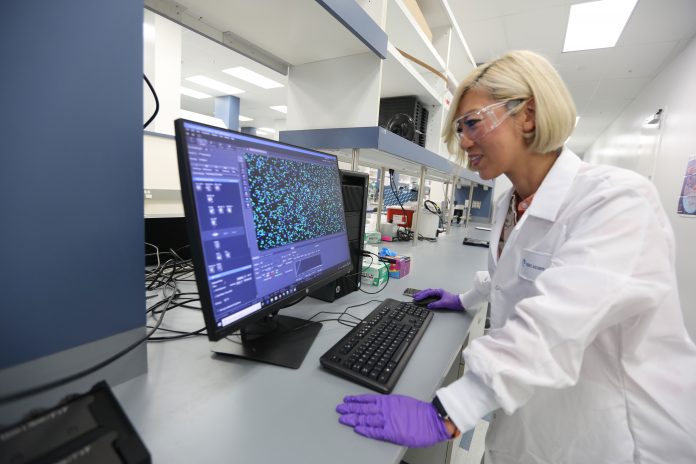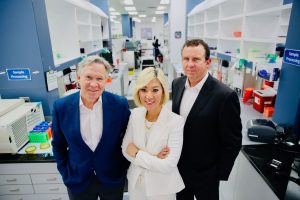
In the realm of liquid biopsy as a tool for precision medicine and the different cells and fractions that can be collected from a standard blood draw, there has always been a sense that there is something missing. Circulating tumor cells (CTCs,) hard to collect, and even harder to collect as a viable cell, would never be the source of all the information needed to make a targeted cancer diagnosis. Likewise, cell-free DNA (cfDNA) and circulating tumor DNA (ctDNA) are already widely used for diagnostic purposes, but due to their very nature as fragments of DNA, the information they can provide for care givers will always be incomplete.
But what if you could combine the best of both worlds: the snapshot-in-time information from ctDNA, single-cell sequencing of viable CTCs, all while preserving white blood cells and white blood cell conjugates that can be further analyzed? Well that’s the cancer diagnostics approach San Diego-based Epic Sciences is pursuing as it aims to be one of the very few companies that can provide the vital information contained in both ctDNA and CTCs to help guide precision treatment decisions.
The 12-year-old biotech company has always had an intriguing technology for CTC detection that captures viable CTCs, which can then be sequenced to illuminate a cancer’s unique nature. But for the first eight years or so of its existence, Epic provided its technology almost exclusively for use in the research setting.
The exception to this was its development of the AR-V7 test, which is currently the only Medicare-reimbursed predictive CTC-based liquid biopsy for metastatic castration-resistant prostate cancer (mCRPC). Since, at the time of its development, Epic didn’t have the in-house capability to commercialize the test, it shopped around for various partners, eventually settling on Genomic Health.
But it was during the process of searching for a partner for AR-V7 that the seeds were sown for a transformation of Epic from a company with a research focus to one aiming to seize a significant opportunity as a developer of a range of comprehensive liquid biopsy diagnostic products.
Loved the technology
As Epic searched for its AR-V7 partner, it brought its test and technology to the attention of one of the largest players in the cancer diagnostics space, Myriad Genetics.
“Around 2015, Rick (Wenstrup, current chief medical officer of Epic) and I were at Myriad,” said Lloyd Sanders, Epic’s chief executive officer. “I was general manager of the oncology division and Rick was the company’s chief medical officer and we did due diligence on Epic for a potential partnership around AR-V7, the same AR-V7 deal that went to Genomic Health.”
“We both left that experience completely sold that this company, this technology, had something to offer above and beyond ctDNA, and certainly above and beyond analyzing tumor,” Sanders said.
The core technology that attracted both Sanders and Wenstrup was developed by company founder Peter Kuhn while he was at the Scripps Institute. While many CTC technologies seek to physically capture and isolate the cells themselves from a blood sample, Kuhn’s method instead plates all 300 million cells from a blood draw on slides and then identifies any CTCs in the sample by leveraging the visualization capabilities inherent in artificial intelligence. Further, the technology not only finds the CTCs in a sample, but also maps every individual cell to a specific X,Y coordinate on the sample slide.
“What I loved about Epic was that it combined the older technology like what Cell Search developed, but it wasn’t just enumeration, it was something that could do both CTC enumeration and it was also a biomarker platform,” said Wenstrup.
“It was likely to be more sensitive, because every cell— or even non-cellular entities like exosomes, could be identified and given a specific X,Y coordinate on a slide, and they could use their technology to identify and characterize every single cell on the slide, which meant all white cells as well as CTCs or CTC-like bodies,” he said.
As Jiyun Byun, Epic’s director of computer vision technologies puts it, the Epic technology is akin to being the Google Earth of cells in a blood sample. That means with coordinates of every cell logged and saved, researchers can go back one, three, or many years later and find the CTC on the slide and pick it for further analysis.
And with her background in AI and computer vision, Byun is focused on improving the accuracy of the technology in identifying cells. “We have to make sure we don’t miss anything and have an accuracy rate that is the same as a self-driving car,” she said. “Because one single cell may change a person’s life, so we don’t want to miss anything.”
Opportunity arises
For Sanders and Wenstrup, once the AR-V7 deal went to Genomic Health it might have ended there. But there was something about the technology—and it’s potential—that stuck with both of them.
“I probably looked at 200 companies, at least, in this space over three years for due diligence at Myriad and Epic was one of my very favorites,” Wenstrup noted.

A bit more than three years after Sanders had done due diligence on Epic, he was still running Myriad’s oncology division and had no plans to leave when he learned that Epic’s CEO was stepping down.
“I didn’t even have an updated resume when the opportunity came across my desk, but when I saw it, I said: ‘OK well this is Epic, which is different than all the others, I have to pursue this.’ So I set about getting that job as soon as I became aware of it,” Sanders said. “Because I knew the company, I knew the people that were here, and I came into the interview process already sold on the technology.”
Sanders took over as CEO of Epic from its previous CEO Murali Prahalad in March of 2019 and has aggressively moved to rework the senior management of the company. Wenstrup joined the company the next month, and in December he added life sciences veteran Joel Smith as CFO and general counsel.
“Murali has remained on the board and that has provided real continuity for us,” Sanders said. “He is a scientist and did some great things here. But our job now is to move this to the next level. Our team is new [to Epic], but has a lot experience and can figure out commercially what is going to make a difference. And, to me, that is 100% about improving patient outcomes.”
No information left behind
As Sanders sees it, a turning point for Epic took place with advice it received from key opinion leaders—researchers in the cancer field—as it was launching an ambitious program to create new liquid biopsy diagnostics for breast cancer. The researchers let Sanders know that for their purposes of diagnosing cancer, or metastatic cancer, or monitoring therapy response, CTCs weren’t going to provide all the information the clinicians need to treat patients earlier, and more effectively.
But it wasn’t just Epic taking this single-minded approach, scores of companies working in the ctDNA space also stayed focused on their specific technologies. “We all doubled down on our own technology, so we didn’t seek to answer the most important questions facing patients and physicians in cancer,” Sanders said. “We only sought to answer the important question facing these patients, that our technology could answer.”
This information led Epic to not focus on a single analyte for its breast cancer program. Now instead of a singular focus on CTCs, it has broadened its approach to derive as much information as it can from a single blood draw.
“We are in a different place now because of the breast cancer program,” Sanders noted. “We figured out that no single technology was going to allow the breast cancer program to flourish if all we did is double down on CTCs. There is a lot of information contained in a vial of blood. We call (our approach) comprehensive cancer profiling, which examines CTCs, ctDNA, and immune cells, or white blood cells.”
According to Wenstrup, the move to breast cancer diagnostic development was a natural next step for Epic, based on its success in prostate cancer.
“There are no more similar cancers biologically to prostate cancer than breast cancer—hormone-drive tumors that are composed of the same embryological analoga, that shed lots of CTCs,” Wenstrup pointed out. “From a purely bio- logical and technical standpoint, it was a natural leap. And Lloyd and I having spent many years at Myriad, let’s just
say that helping people with breast cancer was an area that was interesting to us.”
Aside from the biological similarity of breast and prostate cancer, a second compelling reason to develop a non-invasive diagnostic for metastatic breast cancer is because get- ting the biopsy for metastatic disease often can be difficult. “At the time of first recurrence, years after adjuvant therapy, it’s hard to get that biopsy,” Wenstrup noted. “It is often in bone, or in a difficult area, or in deep visceral tissue like liver or lung.”
These challenges are especially acute in the community setting where, especially if it is a bone biopsy, not all community cancer centers can do this effectively enough to collect enough tissue to identify that it is actually metastatic disease and not the development of a second primary cancer.
Further, getting the secondary biopsy is included in treatment guidelines and is reimbursed by payers. “So if you can come up with an equivalent liquid biopsy that is cheaper, less invasive to patients, but also provide the same information, it would be very be valuable to both patients and physicians,” Sanders said.
Sanders also noted the potential of a comprehensive liquid biopsy to be used post-adjuvant therapy to see how effective it has been in knocking out a patient’s disease. “If you find CTCs after adjuvant breast cancer therapy, you could provide additional therapy beyond what is standard of care today to prevent that,” he said. “That is curative intent.”
While there is obvious value in replacing tissue biopsy with a liquid biopsy in these instances, the team at Epic also has its sights set on helping to build a new diagnostic and treatment paradigm, one in which liquid biopsy can be used to monitor patients in remission to help identify the 30% of patients whose cancers return—and to do this before the cancer is clinically apparent, either via symptoms or imaging.
“If you can identify in the bloodstream a metastatic cancer at the time that it is clinically apparent, could you have found it a year earlier, could you have found it two years earlier, with essentially the same test as is used when the distant recurrence is found?” Wenstrup asked.
Epic is seeking those answers, he added, via its involvement in three separate cooperative studies. Positive results from these and other studies could create the new model many envision of ongoing surveillance throughout a patient’s cancer journey. And the belief at Epic is that the combination of CTC and ctDNA technologies—and eventually white blood cell analysis—puts the company in a leading position to deliver on this promise.













